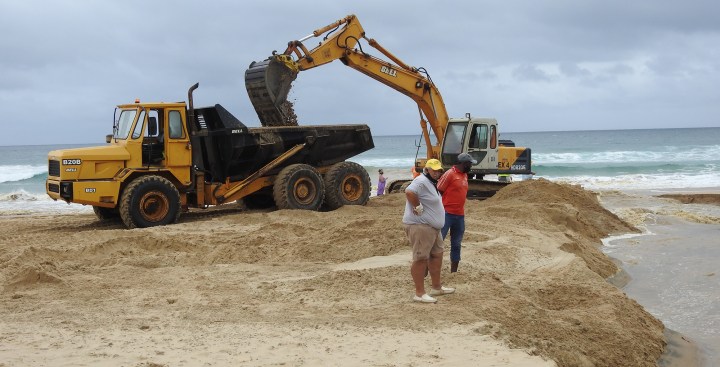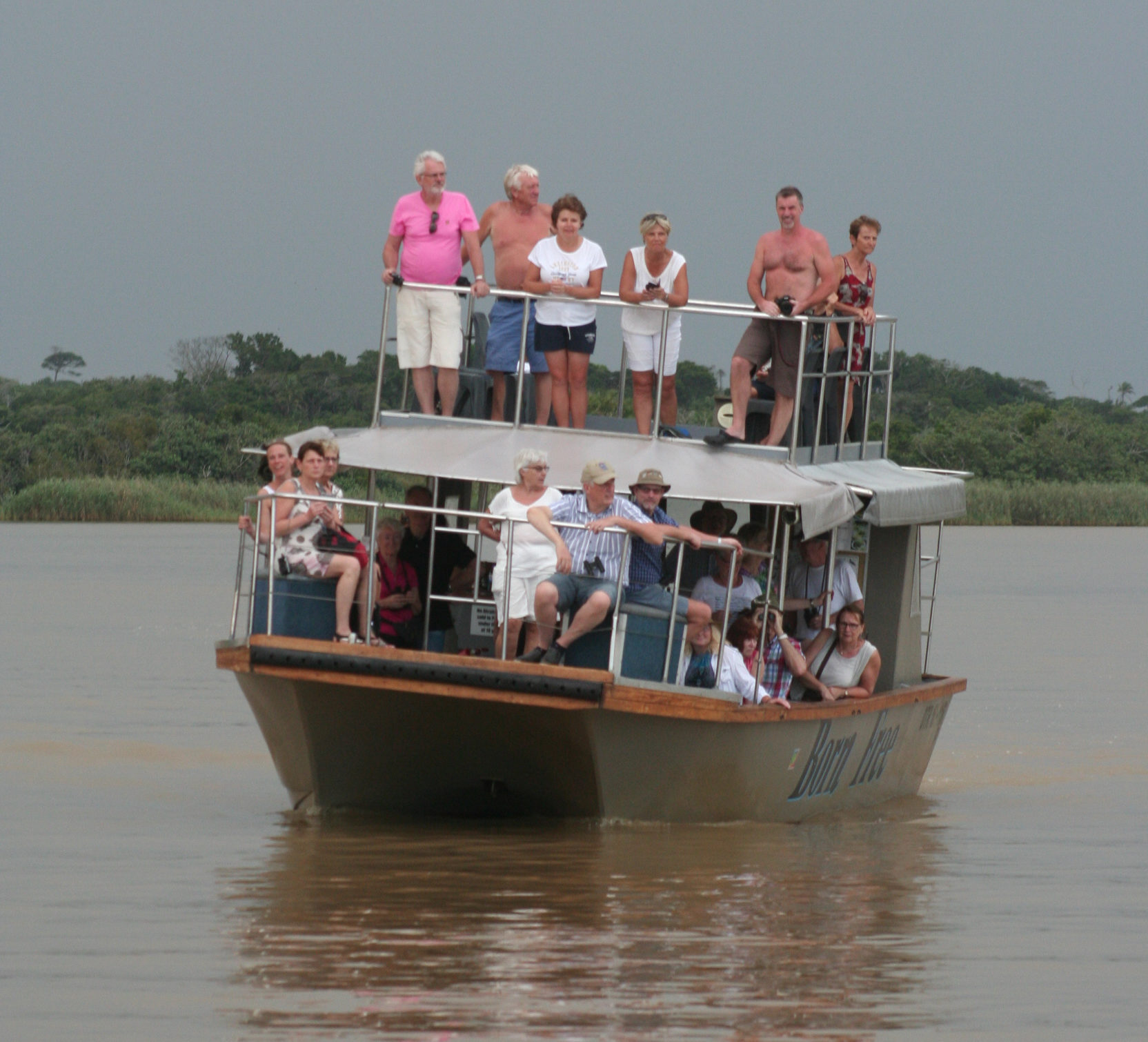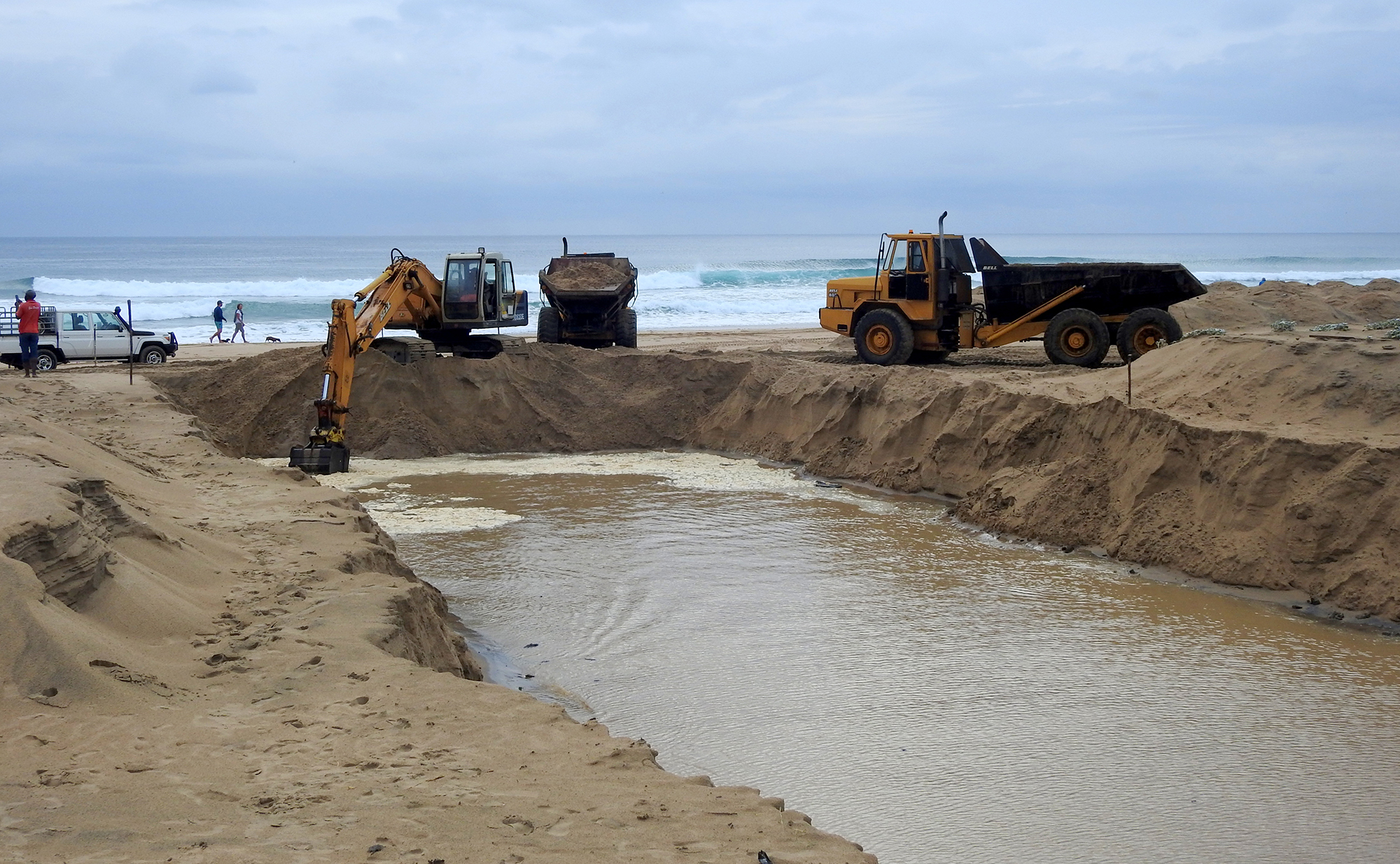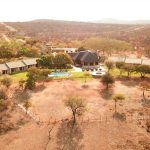OUR BURNING PLANET
Top water scientists fuming after ‘God’s yellow machines’ smash open Lake St Lucia mouth

An estimated R747-million was reported to have been spent on a bold plan to restore the natural ecology of one of South Africa’s first World Heritage sites after 60 years of continuous human interference. Now a group of top water and ecology scientists have asked environment minister Barbara Creecy to explain who authorised the sudden policy flip-flop on artificially breaching the Lake St Lucia mouth.
There was a palpable sense of euphoria among many residents of the far northern KwaZulu-Natal village of St Lucia as they watched millions of litres of fresh water pouring out of South Africa’s biggest estuarine lake earlier this month, followed by a major influx of salt water from the Indian Ocean.
Social media platforms were abuzz with “thumbs up” and “awesome” emoticons as locals, anglers and tourism operations congratulated the iSimangaliso Wetland Park Authority and civic leaders for finally removing a berm of sand which had blocked the lake mouth for several years.

Some tour operators said they were worried that boat-based hippo and crocodile watching tours were under threat unless the mouth was breached to reduce muddy water sediments and reed growth after a prolonged period of mouth closure. (Photo: Tony Carnie)
Now that the mouth was breached, the sea would bring “life” and plentiful stocks of sea fish back into the lake. Some said the next step was to bring back dredgers to keep the mouth open forever – and why not also lift the ban on 4×4 vehicles so that anglers could drive down to their favourite fishing spots, just like they used to do in the good old days.

The good old days, a post by Andrew Joubert. (Photo: Facebook / Andrew Joubert)
There were also dark mutterings on several St Lucia Facebook groups about the “slim mense”, “kwerekweres”, “mafikizolos” (newcomers) and other assorted “idioots”, killjoys and outsiders who did not share this euphoria and dared to question the wisdom of breaking open the mouth to “restore nature”.
(One resident kindly offered to reward this writer with “a hard bliksem” for writing an article voicing criticism on the artificial mouth breaching.)
But now that the mouth is open and the volume of cheering has dimmed somewhat, seven top water and estuarine scientists have written an open letter to Barbara Creecy, the national Minister of Environment, Forestry and Fisheries, asking some tough questions.
The letter – which will also be sent to the United Nations’ World Heritage Committee, The World Bank, Global Environment Facility (GEF) and other interest groups – questions how the park authority came to its decision to authorise mechanical breaching. Was it legal?

Hippo on the move in search of water during previous droughts that dried up large sections of the lake (Photo: Tony Carnie)
Was the park authority still committed to scientific, evidence-based management decisions, or had it now chosen to ditch management strategies based on the expert advice of scores of scientists and partly implemented at a cost of several hundred million rands?
The seven scientists – Prof Anthony “Ticky” Forbes, Nicolette Forbes, Prof Derek Stretch, Dr Barry Clark, Dr Jane Turpie, Eddie Bosman and Prof Gerrit Basson – said iSimangaliso “seems to have abandoned its own management strategy and ignored the scientific evidence on which this strategy is based”.
“In addition to committing significant time and effort to the GEF project and outcomes between 2010-2017, the iSimangaliso Park Authority also made a significant financial contribution, initially committing US$12.7-million and then being able to leverage extra funds to extend this to a contributed total of US$49-million to the restoration initiative.”

Park authorities claim they simply wished to ‘skim’ a sand berm at the estuary mouth to give nature a helping hand – but several images and video clips show that a deep straight-line channel was dug almost to the waterline of the sea. (Photo: Supplied)
The seven researchers said: “The actions taken on 6 January are directly contrary to the outcomes envisaged by this substantial commitment and we hope that the current pathway can be halted and the restoration of this estuary brought back to a scientifically robust and data-driven process.
“As scientists and as citizens, we respectfully request that you, as the minister, source and provide an explanation regarding this deviation from scientific, evidence-based management decisions.”
They said the latest events also flew directly against recommendations made to the then department of water affairs in 2016 that “Lake St Lucia estuary mouth should not be breached artificially except in emergency or when exceptional circumstances prevail”.
“We know of no information nor circumstances preceding this breaching event that could constitute an ‘emergency’ or ‘exceptional’ circumstances.”
In their letter to Creecy, the scientists explain the rationale for new strategies to reverse a 60-year-old policy of regular human intervention which starved the lake of more than 60% of the water that originally flowed into it.
These interventions included diverting the mouth of the Umfolozi River away from St Lucia to prevent back-flooding of commercial sugar crops planted in this river’s floodplain and to reduce the volume of river sediments entering the St Lucia mouth area.
Science and hydrology experts who met at St Lucia in 2010 said it had become clear that this was contributing significantly to the gradual drying out of the lake over time. In a comprehensive report to the Water Research Commission, they said the time for action to restore natural processes was long overdue.
Creecy has not yet responded to the letter or to questions from Daily Maverick, although iSimangaliso issued a media statement shortly after the breaching, stating that the lake and sea had been “successfully connected” after a “multi-disciplinary and multi-sectoral task team” recommended that the system needed “nudging” to support natural processes.
It said “nudging“ had been defined by the task team as “an immediate short-term solution to mark the beginning of the implementation of an action plan, which seeks to implement short-, medium- and long-term solutions to the St Lucia estuary problem, which has been ongoing for decades.”
Quoting WildOceans marine ecologist Dr Jean Harris, the park statement said: “Scientific information is used by the task team as the foundation for decision-making, based on ecological considerations and the conservation of the biodiversity of the system, but social and economic information also plays a critical role.”
The authority attributed this statement to Harris and named her as chair of the task team – but Harris told Daily Maverick this was not correct.
“No. I facilitated it (the symposium initiated at St Lucia in October). I did not chair it.”
Harris said a series of meetings and workshops were initiated by the park authority and Ezemvelo KZN Wildlife management agency who wanted to have a consultative process to respond to issues raised by several stakeholders and to discuss whether any interventions were required to resolve a “difficult and complex issue”.
The discussion had included scientists, although “some decided not to attend”.
Nicolette Forbes, who was invited to the symposium, told Daily Maverick that she was reluctant to take part in a “tainted, rubber-stamping process”, while Dr Derek Stretch has indicated that he attended part of the symposium but decided to withdraw as he feared scientific inputs were being disregarded.
Harris said the task team appointed after the symposium met twice and at the second meeting a decision was taken to reconnect the sea and lake “not by breaking through to the sea”, but by “skimming” the mouth berm to 1.6m above the high-water mark of the sea.
“It (breaching) was not being induced. The intention was just to skim it to 1.6m and nothing more.”
It was felt that in a normal situation, reducing the height to this level would result in a “natural breach” at some point, but it appeared that the sand and mud in the berm was very tightly compacted.
“The intention was to flatten the height of the sand berm… whether it ended up slightly differently, that was the plan.”
This “skimming” narrative was repeated by senior iSimangaliso official Sizo Sibiya in an eNCA interview shortly before the diggers broke through to the ocean.
However, numerous video clips posted on social media strongly suggest that the contractor carved a straight-line channel directly to the sea shore and did not stop digging until lake water emptied into the ocean.
In a Facebook post about the breaching, a local observer, who gave his name as Bjorn Hoffman, commented: “Personally I feel that the mouth was opened by people who know ADTs, TLBs (backhoe machinery), excavators and tractors, with little to no environmental background.
“It’s like they got gatvol and after a few dops just decided ‘today is the day’.”
Hoffman hoped the mouth area could be dredged to keep it open, but cautioned: “We need to pray we do not lose too much fresh water in the system, or else someone will be sitting red-faced, not just from his dop, but from shame that his actions led to a disaster and set the system back years in terms of getting back what we all want… a fully functioning and mostly self-sustainable estuary.”
Earlier this month, St Lucia Ratepayers Association spokesman Rudi Redinger flatly refused to discuss the breaching issue. However, a transcription of comments recorded on video at the recent symposium suggest that Redinger was one of the most ardent advocates for the mouth to be opened immediately.
He told the symposium that urgent interventions were needed as there had been extensive human interference in the Lake St Lucia catchment over many decades.
“It cannot be left 100% to nature,” he said, suggesting that preliminary work be done to skim the beach to a level that “makes it easy to help the lake when it’s needed”.
“It’s not beyond us humans. God has put us here to manage his system and we must help him… Our (symposium working) group says we want yellow machines on the beach… it has to happen. The sooner the better.”
His message was echoed by Elephant Lake Hotel manager Deon Steyn, who said boat-based hippo and crocodile tours in the popular Narrows area were in danger of collapsing because of the volume of mud and sand in this section of the lake.
Steyn said his working group felt the scientific models presented at the symposium were “outdated and don’t match the reality on the ground”, adding that they also wanted the “yellow machines” to get going.
iSimangaliso has yet to reveal the cost of the operation; the name of the contractor hired to “skim” the beachfront berm or what measures were taken to supervise the process.
In response to questions, the authority said a decision was taken to “assist the lake” to re-establish a link to the sea and this decision was “in line with the St Lucia Estuarine Management Plan through the above-mentioned multi-disciplinary approach”. DM





















 Become an Insider
Become an Insider
Bad farming practices by man caused the lake to silt up and so man must remove this silt. Opening the mouth is not the solution but it is better than turning the lake into a fresh water swamp.
More destruction of precious natural resources through naked greed. It’s so easy to invent arguments to destroy for your own benefit in the name of doing good for others. Shame on you leaving a catastrophe for later generations to live or die through
It is indeed an emotional issue. However, as Bruce points out, man’s ecological intervention upstream, mainly through illicit damming of the river and illegal sluicing of water for farming, has resulted in an inability for the estuary to flush itself for many years now. Yes, this activity is unacceptable – but it happened. And it needed fixing – not only to prevent the estuary becoming a muddy lei, but also because St Lucia is a hugely important spawning ground for many important salt water fish, that are now under breeding threat. So Roy, it’s shame on us for allowing this unfortunate situation to develop in the first place. We’re the ones to blame.
Totally agree. My shame on included all who are responsible for the damage including the cane farmers. My understanding is that the long term rehabilitation process would include restoring the farmed area. Restoration has to include all environmental damage and has to work at nature’s pace so will by definition be long term. I am not a rabid greenie but watching with mounting horror and anxiety the planetary destruction as a result of greed and excess that is my generation’s legacy to our children
I think the “scientists” that are against the opening of the mouth should first go and get some information from the historians, the history of the salinity of the lake, the population of crocodiles and hippos, and local population on the history of the lake for the past 45 years, before they give their “green” tinted comments. Being “green” and having a BSc (in some biological field) does not make you a scientist. It needs a holistic approach. I know at some stage, I think in the early 1970’s, the salinity was higher than sea water. So the mouth was opened to assist nature. At some stage the mouth was closed to prevent oil ingress from a shipwreck. Check the history.
Profits have beaten the environment again. Shame on you, Minister.
Emotions aside, connecting the dots, the real solution is to get the sugar farmers off the flood plain. Restore that ecology to what it was in the first place. That is after the clamour and the rage in answer to this post has died down. If the rural black population could be re-edutated on the problem with the Elephant Park on the Mswati border, why not the white farmers on the flood plain? Neveeeeer!! Too expensive! Really? Why does the status quo just HAVE to be sustained? if you can think it , you can do it, but fear is the key. The rich fear they will lose it all. Ons sal offer wat jy vra, ons vir jou Suid Afrika! One very uncomfortable reason to scotch it. Worse than having grenades lobbed at you.
Thank you for providing some much needed historical background Chris. Sadly lacking from either article. We get lots of emotions and finger pointing but precious little in the way of rational argument for either side. And still no bulldozers!
To breach or not to breach the mouth appears to me not to be dealing with the cause, but fiddling with the symptoms. If cancer is causing septic ulcers, you don’t treat them by applying a band-aid. I am no scientist but it would appear that the problem resides upstream in all the rivers that feed St Lucia. Surely a holistic study on these rivers should be the priority? Get them flowing freely again and I’m sure the estuary will revive itself.